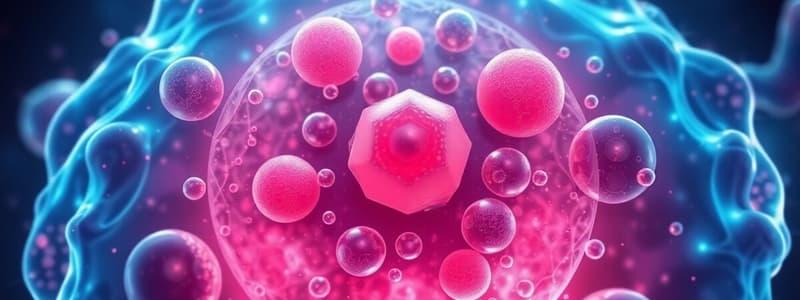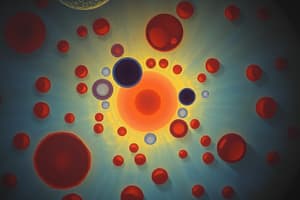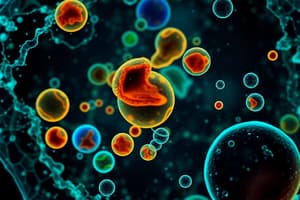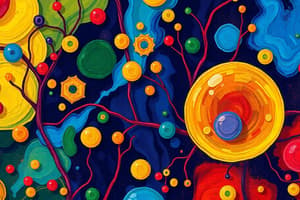Podcast
Questions and Answers
A researcher discovers a new cell type that contains ribosomes, a plasma membrane, but no nucleus. It has a cell wall containing peptidoglycan. Which of the following best describes this cell?
A researcher discovers a new cell type that contains ribosomes, a plasma membrane, but no nucleus. It has a cell wall containing peptidoglycan. Which of the following best describes this cell?
- An archaeal cell lacking typical membrane structures.
- A eukaryotic cell with a modified cell wall.
- A eukaryotic cell that lost its nucleus.
- A prokaryotic cell. (correct)
Which of the following observations best supports the endosymbiotic theory for the origin of eukaryotic organelles?
Which of the following observations best supports the endosymbiotic theory for the origin of eukaryotic organelles?
- The presence of a nucleus in eukaryotic cells.
- The presence of DNA and ribosomes within mitochondria and chloroplasts. (correct)
- The presence of a cell wall in plant cells.
- The ability of eukaryotic cells to perform photosynthesis.
A cell that specializes in producing lipids would likely have a relatively large amount of which organelle?
A cell that specializes in producing lipids would likely have a relatively large amount of which organelle?
- Golgi apparatus
- Smooth endoplasmic reticulum (correct)
- Lysosomes
- Rough endoplasmic reticulum
A mutation disrupts the function of the Golgi apparatus in a eukaryotic cell. What is the most likely consequence of this mutation?
A mutation disrupts the function of the Golgi apparatus in a eukaryotic cell. What is the most likely consequence of this mutation?
Following translation, a protein destined for secretion from the cell is synthesized in the rough endoplasmic reticulum (RER). Which of the following represents the subsequent steps in its processing and transport?
Following translation, a protein destined for secretion from the cell is synthesized in the rough endoplasmic reticulum (RER). Which of the following represents the subsequent steps in its processing and transport?
Which of the following properties of phospholipids is most critical to their ability to form membranes?
Which of the following properties of phospholipids is most critical to their ability to form membranes?
A researcher is studying the transport of glucose across a cell membrane. They observe that glucose transport is much faster than expected based on simple diffusion and is inhibited by a molecule that binds to a specific membrane protein. Which transport mechanism is most likely responsible for glucose movement in this system?
A researcher is studying the transport of glucose across a cell membrane. They observe that glucose transport is much faster than expected based on simple diffusion and is inhibited by a molecule that binds to a specific membrane protein. Which transport mechanism is most likely responsible for glucose movement in this system?
A cell is placed in a solution that causes it to swell and eventually burst. What can you conclude about the solution relative to the cell's cytoplasm?
A cell is placed in a solution that causes it to swell and eventually burst. What can you conclude about the solution relative to the cell's cytoplasm?
Flashcards
Prokaryotic Cells
Prokaryotic Cells
Cells lacking a nucleus or other membrane-bound organelles.
Eukaryotic Cells
Eukaryotic Cells
Cells with a nucleus and other membrane-bound organelles.
Endosymbiotic Theory
Endosymbiotic Theory
Theory that eukaryotic organelles (like mitochondria) evolved from prokaryotic cells engulfed by another cell.
Electronegativity
Electronegativity
Signup and view all the flashcards
Nonpolar Covalent Bond
Nonpolar Covalent Bond
Signup and view all the flashcards
Polar Covalent Bond
Polar Covalent Bond
Signup and view all the flashcards
Ionic Bond
Ionic Bond
Signup and view all the flashcards
Hydrophobic
Hydrophobic
Signup and view all the flashcards
Study Notes
- The unit covers cell structure/function, biomolecules, and membrane structure & transport.
Prokaryotic and Eukaryotic Cells
- Prokaryotic and eukaryotic cells differ significantly in structure and characteristics.
Endosymbiotic Theory
- The endosymbiotic theory explains the origin of certain eukaryotic organelles.
Eukaryotic Organelles
- Eukaryotic cells contain various organelles, each with specific functions that contribute to the cell's overall activity.
Organelle Function in Cell Types
- Specific cell activities depend on particular organelles.
Defective Organelle Consequences
- A defective organelle can have significant consequences for a cell's function and survival.
Protein Export Pathway
- Proteins follow a specific pathway from production to secretion from the cell.
Common Cell Elements and Macromolecules
- Cells are composed of common elements that form four main classes of macromolecules.
- Each of these macromolecules has their corresponding monomers.
Electronegativity
- Electronegativity is a measure of an atom's ability to attract electrons in a chemical bond.
- Differences in electronegativity determine whether a bond is polar covalent, nonpolar covalent, or ionic.
Molecular Behavior in Water
- Molecules with nonpolar covalent bonds behave differently in water compared to those with polar covalent bonds.
Hydrophobic vs. Hydrophilic
- The molecular structure determines whether a molecule is hydrophobic or hydrophilic.
Water Molecules
- A water molecule consists of atoms held together by a specific type of bond.
- Water molecules interact with each other through a specific type of interaction.
Bonds
- Covalent, ionic, and hydrogen bonds differ in strength and how they form.
Phospholipids
- Phospholipids have polar and nonpolar regions that dictate their behavior in water.
Cell Membrane
- A cell membrane is composed of four primary components, which give structure and function.
Membrane Permeability
- The ability of substances to cross a phospholipid bilayer varies based on size, polarity, and charge.
Substance Movement Across Membranes
- The relative concentrations of substances on either side of a membrane affect the direction of movement.
Membrane Fluidity and Permeability
- Membrane fluidity and permeability are affected by the saturation of phospholipids.
Cholesterol Effect on Membrane
- The incorporation of cholesterol impacts membrane permeability.
Solution Tonicity
- Hypertonic, hypotonic, and isotonic solutions differ in their relative solute and water concentrations.
Water Movement in Cells
- The placement of cells in hypertonic, hypotonic, and isotonic environments dictates the direction of water movement.
Energy and Concentration Gradients
- The movement of substances across cell membranes may or may not require energy, depending on the concentration gradient.
Transport Proteins
- Membrane transport that involves the use of transport proteins includes the use of carriers, channel, and pump membrane proteins.
Studying That Suits You
Use AI to generate personalized quizzes and flashcards to suit your learning preferences.





